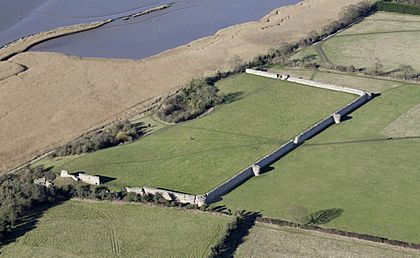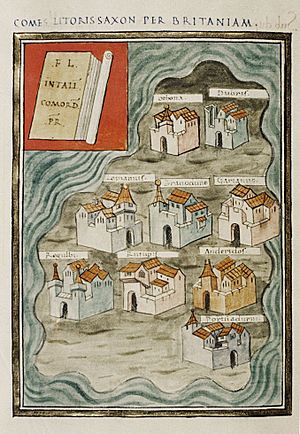Saxon Shore facts for kids
The Saxon Shore (called litus Saxonicum in Latin) was a special military area in the late Roman Empire. It had a chain of strong forts built along both sides of the English Channel. This system was set up in the late 200s AD. It was first led by a commander known as the "Count of the Saxon Shore". Later, his job was only to look after the forts in Britain. The forts in Gaul (modern-day France) then got their own leaders. Many of these Saxon Shore forts can still be seen today in eastern and south-eastern England.
Contents
Why the Forts Were Built

In the second half of the 200s AD, the Roman Empire faced big problems. This time is often called the Crisis of the Third Century. Inside the empire, there were many civil wars. Emperors came and went very quickly. Some parts of the empire even tried to break away. At the same time, new groups of people, often called "barbarian tribes," started attacking the empire's borders.
Most of Britain had been part of the Roman Empire since the mid-100s AD. It was protected in the north by big walls like Hadrian's Wall. The Romans also had a large fleet (navy) to guard the seas.
But as more attacks happened on the empire's edges, the Romans built many forts everywhere. These forts helped protect cities and important places. The Saxon Shore forts were built for this reason. Some forts, like those at Brancaster and Reculver, were built as early as the 230s AD. Other forts in this group were built between the 270s and 290s AD.
The Forts: Britain's Coastal Defenses
A Roman document called the Notitia Dignitatum lists nine main Saxon Shore forts in Britain. Here they are, listed from north to south:
- Branodunum (Brancaster, Norfolk): This was one of the earliest forts, built around 230 AD. It guarded the entrance to The Wash. It had a typical rectangular shape. Roman soldiers called Equites Dalmatae Brandodunenses were stationed here.
- Gariannonum (Burgh Castle, Norfolk): Built between 260 and 275 AD, this fort protected the River Yare. Soldiers known as Equites Stablesiani Gariannoneses were based here.
- Othona (Bradwell-on-Sea, Essex): This fort was home to a group of soldiers called the Numerus Fortensium.
- Regulbium (Reculver, Kent): Like Brancaster, this was an early fort, built around 210 AD. It guarded the mouth of the Thames. Soldiers from the cohors I Baetasiorum were stationed here.
- Rutupiae (Richborough, Kent): Parts of the famous Legio II Augusta (Second Augustan Legion) were based at this fort.
- Dubris (Dover Castle, Kent): This fort was guarded by soldiers called the Milites Tungrecani.
- Portus Lemanis (Lympne, Kent): The Numerus Turnacensium soldiers were stationed here.
- Anderitum (Pevensey Castle, East Sussex): This fort was home to the Numerus Abulcorum.
- Portus Adurni (Portchester Castle, Hampshire): Soldiers called a Numerus Exploratorum were based here.
Other places were also part of this defense system, even if they are not in the Notitia list. These include Walton Castle, Suffolk (which has now sunk into the sea) and Caister-on-Sea. Further west, Carisbrooke Castle on the Isle of Wight and Clausentum (Bitterne, near modern Southampton) were also part of this chain of forts. There were also possible signal stations (watchtowers) along the coast at places like Thornham and Corton.
Further north, the Romans had central supply bases at Lindum (Lincoln) and Malton. Roads led from these bases to coastal signal stations. If an attack was spotted, troops could quickly be sent out. Even further north in North Yorkshire, a series of watchtowers were built along the coast. These towers connected the southern defenses to the main military area near Hadrian's Wall. Similar forts were also found in Wales, at Cardiff and Caer Gybi.
The Forts: Gaul's Coastal Defenses
The Roman document Notitia Dignitatum also lists two separate commands for the northern coast of Gaul (modern-day France). These also belonged to the Saxon Shore system. However, by the time this list was made (around 420 AD), the Romans had already left Britain.
One command looked after the coast of a province called Belgica Secunda. This area was roughly between the Scheldt and Somme rivers. Its commander was called the dux Belgicae Secundae. His main base was at Portus Aepatiaci. Some of the forts in this area included:
- Marcae (near Calais): This fort was guarded by Equites Dalmatae soldiers. The Notitia specifically says this fort was "on the Saxon Shore."
- Locus Quartensis sive Hornensis (at the mouth of the Somme): This was a port for a fleet of ships called the classis Sambrica.
- Portus Aepatiaci (possibly Étaples): This fort was home to milites Nervii soldiers.
The important port of Gesoriacum or Bononia (Boulogne-sur-Mer) was also likely part of this command.
Further west, another commander, the dux tractus Armoricani et Nervicani, looked after the coasts of Armorica (today's Normandy and Brittany). The Notitia lists several places here:
- Grannona (location debated, possibly at the mouth of the Seine): This was the commander's main base. Soldiers from the cohors prima nova Armoricana were stationed here. This fort was also clearly named as being "on the Saxon Shore."
- Rotomagus (Rouen): Guarded by milites Ursariensii soldiers.
- Constantia (Coutances): Home to the legio I Flavia Gallicana Constantia.
- Abricantis (Avranches): Guarded by milites Dalmati.
- Aleto or Aletum (Aleth, near Saint-Malo): Guarded by milites Martensii.
- Osismis (Brest): Guarded by milites Mauri Osismiaci.
- Manatias (Nantes): Guarded by milites superventores.
There are also other places where Roman soldiers might have been present, like the fort known as "The Nunnery" on Alderney island.
Images for kids
-
Roman stone work, with its special bands of Roman tiles, in the walls of the Saxon Shore fort of Anderitum. This fort was later rebuilt as Pevensey Castle in East Sussex.
See also
 In Spanish: Costa sajona para niños
In Spanish: Costa sajona para niños



